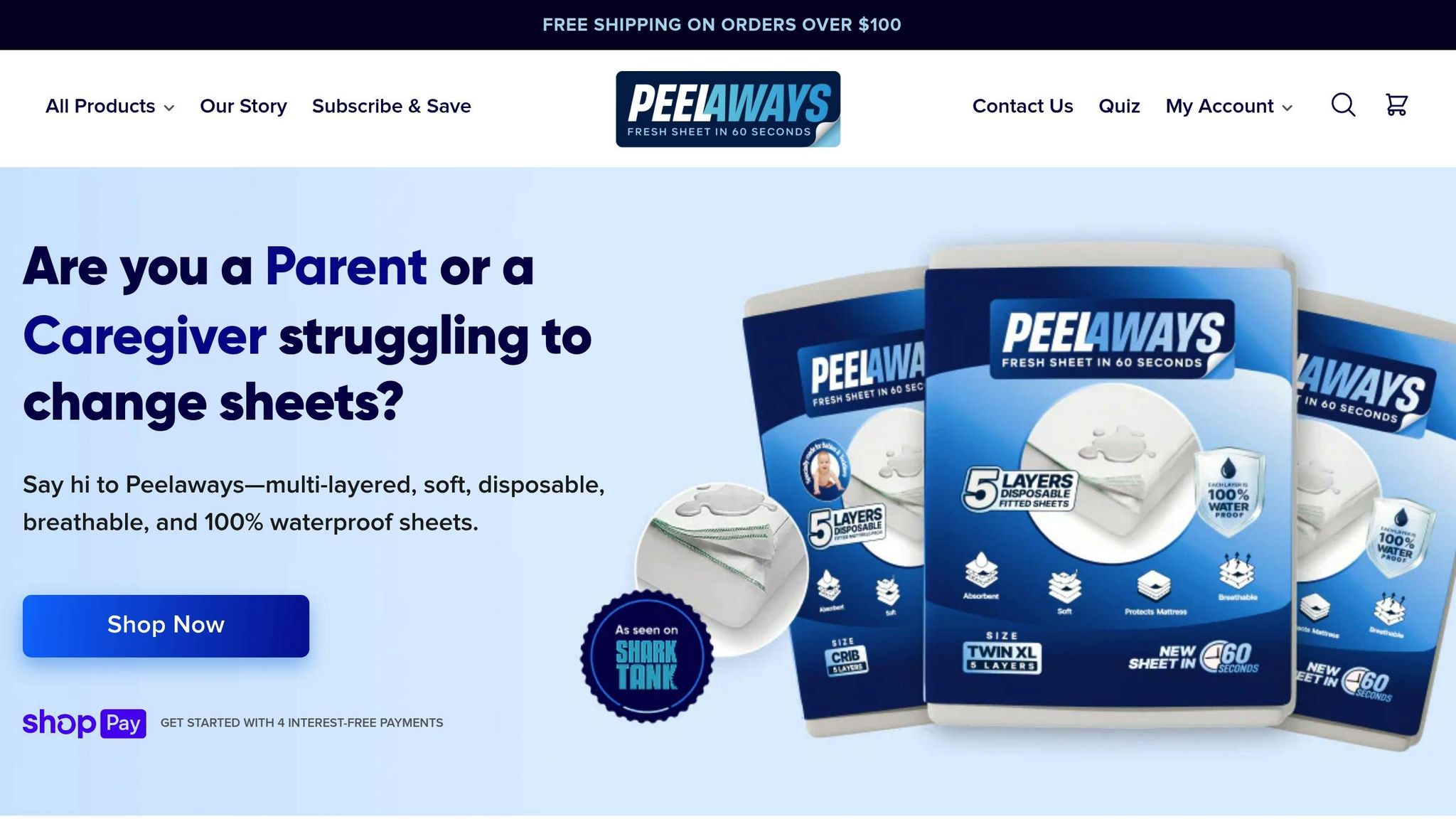Adjustable Beds vs. Standard Beds for Mobility Needs

When choosing a bed for seniors with mobility challenges, adjustable beds often outperform standard beds in terms of safety, comfort, and independence. Here's why:
- Adjustable beds allow users to raise or lower the head and foot sections, making it easier to get in and out of bed, relieve pain, and improve blood circulation. They also reduce caregiver strain by enabling seniors to reposition themselves independently.
- Standard beds are simpler and more affordable but lack the flexibility to meet mobility and health needs. Their fixed height and position can make transfers harder and increase fall risks.
Quick Comparison
| Feature | Adjustable Bed | Standard Bed |
|---|---|---|
| Ease of Transfers | Safer with adjustable height/angle | Harder due to fixed height |
| Pain Relief | Supports joints and reduces strain | Depends on mattress quality |
| Independence | Allows self-adjustments | Often requires caregiver help |
| Cost | Higher upfront cost | More budget-friendly |
| Power Dependency | Requires electricity | No power needed |
If mobility, pain relief, or independence are key concerns, adjustable beds are worth considering despite the higher cost. For those prioritizing simplicity and budget, standard beds may suffice but may require additional aids.
Adjustable Beds: Features, Benefits, and Who They Help
What Adjustable Beds Offer
Adjustable beds come with motorized mechanisms that let users independently raise or lower the head and foot sections. Many models include wireless remotes with large, easy-to-use buttons and memory settings for quick adjustments. Some even feature split bases, allowing partners to customize their side of the bed without disturbing each other. To enhance safety, these beds often include anti-entrapment mechanisms, emergency lowering functions to quickly return the bed to a flat position, and optional safety rails to prevent falls. These thoughtful designs bring increased comfort and mobility, particularly for seniors.
How Adjustable Beds Help Seniors
Adjustable beds make getting in and out of bed easier by allowing users to change the bed's height and angle. They can provide relief from pain by evenly distributing body weight and reducing pressure on joints. By supporting proper spinal alignment, these beds can help alleviate chronic back pain. For seniors with circulation problems, raising the legs can improve blood flow and reduce swelling in the feet and ankles. Elevating the head can also ease symptoms of sleep apnea, snoring, and acid reflux by helping to open airways.
The ability to self-adjust these beds not only promotes independence for seniors but also lessens the physical demands on family members and caregivers.
Who Should Consider Adjustable Beds
Seniors with arthritis often benefit from the flexible positioning, which can reduce joint stiffness and pain. Those dealing with chronic back pain or recovering from back surgery may find the spine-supporting configurations particularly useful. Adjustable beds also help individuals with respiratory conditions like sleep apnea or COPD by elevating the head to keep airways open.
For seniors with mobility challenges, these beds make transfers safer and more manageable by adjusting to the ideal height and angle. Those who spend much of their day in bed due to illness or recovery can benefit from pressure redistribution, which helps prevent pressure sores and promotes better circulation. For seniors facing daily mobility hurdles, these features can offer a valuable sense of independence, making them an excellent option for safe and comfortable home care.
Standard Beds: Features, Benefits, and Drawbacks
What Standard Beds Provide
Standard beds come with a fixed frame and maintain a consistent mattress height, offering a straightforward and familiar sleeping surface. They don’t rely on mechanical or electronic components, meaning there’s no need for ongoing maintenance or learning how to operate complex mechanisms. Instead, the comfort and support they provide depend entirely on the mattress you select. Whether you prefer innerspring, memory foam, latex, or hybrid models, standard beds are compatible with nearly all mattress types. They also come in various sizes, from twin to California king, making it easy to find one that suits your needs.
Advantages of Standard Beds
One of the biggest perks of standard beds is their affordability. Basic models typically cost between $200 and $500, which is significantly less than adjustable beds, which often start at $1,000 [1][4][8]. Their simple design makes them easy to assemble, with no need for electrical hookups or worrying about power cords and outlets. Plus, the lack of moving parts means minimal maintenance, and they remain functional even during power outages.
Another advantage is their lightweight construction, which makes them easier to move around - whether you’re rearranging furniture or relocating to a new home. They’re also available in a wide range of styles and finishes, so finding one that complements your home décor is simple. However, despite these benefits, the fixed design can present challenges for seniors dealing with mobility issues.
Where Standard Beds Fall Short for Seniors
For seniors, the fixed height and lack of adjustability can create significant difficulties. Beds that are too high or too low can make getting in and out of bed a struggle, increasing the risk of falls. Additionally, the inability to adjust the head or foot of the bed limits options for alleviating chronic pain, arthritis, or circulation problems. This can be particularly problematic for seniors dealing with conditions like sleep apnea, acid reflux, or breathing difficulties, where elevation is often essential for relief.
Research shows that adjustability is a key factor for many older adults. In fact, 62% of users over the age of 54 opt for adjustable beds specifically to address joint pain and mobility challenges [6]. Standard beds also make transferring in and out of bed more difficult for seniors with limited mobility, often requiring assistance from caregivers, which can reduce a sense of independence. For those who spend extended periods in bed due to illness or recovery, the lack of pressure redistribution features can lead to issues like pressure sores and poor circulation.
While products like PeelAways disposable bedsheets can simplify hygiene by eliminating the need to lift the mattress during bedding changes, they don’t address the core mobility and functionality limitations of standard beds for seniors.
Adjustable Beds vs Standard Beds: Direct Comparison
Feature and Benefit Comparison Chart
When choosing a bed that suits seniors' mobility needs, it's crucial to weigh the features of adjustable and standard beds. Research highlights that 62% of individuals over age 54 who purchased adjustable beds did so due to joint pain and mobility concerns [6]. This underscores the importance of selecting the right bed type for specific health challenges.
Here's a detailed comparison of how these two bed types measure up on key factors for seniors dealing with mobility issues:
| Feature | Adjustable Bed | Standard Bed |
|---|---|---|
| Posture Support | Excellent: adapts to body and maintains neutral spine | Variable: depends on mattress, less adaptable |
| Pressure Relief | Excellent: reduces pressure points | Fair: can create pressure points |
| Accessibility | Excellent: adjustable height/angle for easy entry/exit | Poor: fixed height, harder for mobility issues |
| Partner Disturbance | Minimal (split models): independent controls | High: movements disturb partners |
| Snoring/Breathing Aid | Good: head elevation opens airways | Poor: lying flat can worsen snoring/breathing |
| Back Pain Relief | Good: customizable positions reduce spinal strain | Limited: dependent on pillows |
| Circulation/Swelling | Good: leg elevation improves blood flow | Poor: requires manual propping, less consistent |
| Mattress Compatibility | Limited: needs flexible mattress (foam, latex, hybrids) | Excellent: compatible with almost all mattress types |
| Weight/Portability | Heavy: difficult to move | Lighter: easier to move |
| Cost | Higher: investment | Lower: more budget-friendly |
| Power Requirement | Yes: needs electricity | No: operates without power |
| Maintenance | More: moving parts and electronics | Minimal: fewer components |
| Aesthetics | Good: designed to look like regular beds, various styles | Good: wide variety of styles |
This side-by-side breakdown highlights how adjustable beds cater to specific health and mobility needs, while standard beds offer a simpler, more cost-effective option.
Adjustable beds stand out for their ability to lower fall risks. By allowing users to modify the bed's height and position, they make getting in and out safer and more manageable. They also provide relief for joint pain and chronic conditions, enabling independent transfers [1][3][6]. Standard beds, on the other hand, often require additional aids, which may not offer the same level of consistency or ease [1][2][3][6].
Another key advantage of adjustable beds is their role in promoting independence. Seniors can change positions without relying on assistance, reducing strain on caregivers and maintaining a sense of privacy. In contrast, standard beds typically demand manual adjustments or physical help, which can be challenging for both seniors and their caregivers [1][3][6].
Cost is an important consideration. While adjustable beds come with a higher upfront price and require maintenance, they can potentially lower long-term healthcare costs by preventing falls and managing chronic conditions more effectively. Standard beds are less expensive initially, but they might need extra accessories or modifications to meet mobility needs [1][5].
One notable difference between the two is power dependency. Adjustable beds rely on electricity, which means they won't function during power outages - an important factor for seniors living in areas prone to interruptions. Standard beds, however, operate without electricity, offering reliability in any situation [1][7].
sbb-itb-45288fe
Bedding Solutions for Seniors: Comfort and Hygiene
Why Bedding Matters for Seniors
Selecting the right bedding can significantly impact the comfort and care of seniors, especially those with mobility challenges. For instance, incontinence affects nearly half of nursing home residents, making waterproof, easy-to-change bedding a practical necessity rather than a luxury[6].
Seniors who spend extended time in bed are at a higher risk of skin issues like pressure sores and discomfort if their bedding isn’t soft, breathable, and moisture-wicking. Traditional cotton sheets often complicate care, requiring more effort to strip, wash, and remake - processes that can increase the risk of cross-contamination.
Waterproof bedding plays a key role in preventing damage and controlling infections. A single accident on regular sheets can lead to liquids seeping through, resulting in unpleasant odors or costly damage to mattresses.
Infection control is another critical factor, particularly for seniors with weakened immune systems. Even frequent washing of traditional sheets might not fully eliminate bacteria and odors, especially when accidents aren’t addressed immediately. These challenges are even more pronounced in at-home care settings, where time and resources may be limited. To address these issues, solutions like disposable bedsheets offer a practical way to improve hygiene and simplify care routines.
PeelAways Disposable Bedsheets: A Practical Solution

PeelAways disposable bedsheets provide an innovative answer to many of the challenges associated with traditional bedding in senior care. Designed with 5–7 soft, absorbent layers, these sheets allow caregivers to peel away a soiled layer, revealing a fresh, waterproof surface underneath.
This design eliminates the need for lifting mattresses or immediate laundering, while also reducing the risk of cross-contamination. The sheets are both waterproof and breathable, ensuring liquids are contained without sacrificing airflow, which helps keep seniors comfortable and dry.
"These have saved my sanity! They hold a LOT of liquid and are easy to use and tear away. No more 15 loads of laundry and wet mattresses!" - Jalene Stanger[9]
PeelAways are available in all major U.S. bed sizes, including Twin XL (commonly used with adjustable beds), as well as Twin, Full, Queen, and King sizes. This flexibility makes them suitable for various bed types, whether adjustable or standard, catering to the needs of seniors with mobility challenges.
For seniors dealing with limited mobility or night sweats, the ability to quickly access a clean layer without a full bed change helps maintain dignity and independence.
"When he has an accident, he now can take care of it himself and put a new top sheet on his bed. No more scrubbing, no more smell, and no more embarrassment." - Ronda[9]
PeelAways also prioritize chemical safety, an essential consideration for seniors with sensitive skin. They are free from harsh substances like Vinyl, PVC, Phthalates, and fire retardants. Additionally, they are latex-free and hypoallergenic, reducing the risk of skin irritation.
Traditional sheet changes often require considerable time and physical effort, which can strain caregivers. In contrast, replacing a soiled PeelAways layer takes less than a minute, eliminating the need to strip the entire bed or move the senior.
While PeelAways cost between $30.99 and $53.99 per pack, depending on size, they can save money in the long run by protecting mattresses from damage and cutting down on laundry expenses. Families managing frequent accidents may find significant savings in reduced water, detergent, and energy use.
With over 6,000 five-star reviews and an impressive average rating of 4.8 stars, PeelAways have proven to be a trusted choice in senior care[9]. Whether you're using an adjustable or standard bed, the right bedding solution can greatly improve a senior’s comfort while streamlining caregiver responsibilities.
Choosing the Right Bed for Seniors with Mobility Needs
Main Points to Remember
When selecting a bed for a senior with mobility challenges, it’s essential to focus on their specific health and movement needs. Adjustable beds stand out because they allow for customizable positioning. Seniors can elevate their head or legs to improve circulation, reduce swelling, or make breathing easier. This feature can also simplify getting in and out of bed for those with limited mobility.
Here’s a telling statistic: 62% of individuals over the age of 54 purchase adjustable beds to address joint pain and mobility concerns[6]. This shows how effective these beds can be compared to standard beds in managing mobility issues.
The major advantage of adjustable beds is their ability to adapt to specific conditions like sleep apnea, acid reflux, or chronic back pain. Standard beds, on the other hand, rely on mattress quality or additional pillows for support, which may not be as effective. For seniors who spend a lot of time in bed or need frequent repositioning, this adaptability can make a huge difference in their comfort and quality of life.
While adjustable beds often come with a higher upfront cost, they can potentially reduce long-term care needs. By enabling more independence and requiring less caregiver assistance for repositioning, these beds offer both practical and financial benefits. This makes them an important consideration for caregivers looking to enhance comfort and autonomy for their loved ones.
What Caregivers Must Evaluate
Caregivers need to take a closer look at the senior’s specific requirements before making a decision. Start by assessing their current mobility and any health conditions. For example, seniors dealing with arthritis, edema, or respiratory issues may see significant benefits from the adjustable features.
Another key factor to consider is the senior’s ability to transfer in and out of bed independently. Adjustable beds can make transfers easier, reducing strain on both the senior and their caregiver. In contrast, the fixed height of standard beds might become problematic as mobility decreases over time.
Budget considerations shouldn’t stop at the purchase price. Adjustable beds often require access to power outlets and may need more space due to their movable bases. Additionally, flexible mattresses designed for these beds are a must to ensure smooth operation.
Don’t forget about bedding. Seniors with mobility challenges may benefit from specialized options like PeelAways disposable bedsheets. These sheets are compatible with both adjustable and standard beds, offering waterproof protection and easy cleanup, which can save caregivers valuable time and effort.
Lastly, consult healthcare professionals or occupational therapists. Their expertise can provide tailored recommendations based on the senior’s current mobility and any anticipated changes in their condition.
How to Get Out of Bed Safely Using an Adjustable Bed
FAQs
What are the advantages of adjustable beds over standard beds for seniors with mobility issues?
Adjustable beds offer a range of benefits for seniors dealing with mobility issues. By allowing users to change the bed's position, these beds make it easier to get in and out, while also providing improved support for sitting up or lying down. This can help reduce physical strain and encourage greater independence.
They also improve overall comfort by minimizing pressure points and aiding circulation - an advantage for those with mobility limitations or specific health concerns. For added ease, Peelaways disposable, multi-layered bed sheets are a game-changer. Caregivers can simply peel off a soiled layer to reveal a fresh one underneath, saving time, effort, and ensuring cleanliness.
How can adjustable beds help seniors with pain relief and circulation issues?
Adjustable beds can be a game-changer for seniors, offering the ability to customize sleep positions to ease pressure on joints and muscles. This can go a long way in helping to reduce pain and discomfort. Plus, raising the legs or head can enhance blood flow, which supports better circulation and helps minimize swelling.
For even greater convenience, Peelaways disposable bed sheets offer a smart solution. These sheets feature a multi-layer design that's soft, absorbent, and waterproof. When one layer gets soiled, you simply peel it off to reveal a fresh, clean sheet underneath - no need for heavy lifting or extra laundry. Available in Twin, Full, Queen, and King sizes, Peelaways are a practical choice for caregiving and senior comfort.
What should caregivers keep in mind when deciding between an adjustable bed and a standard bed for a senior with mobility challenges?
When choosing between an adjustable bed and a standard bed for a senior with mobility challenges, there are a few important factors to weigh:
- Mobility and health considerations: Adjustable beds can offer better support for seniors dealing with issues like arthritis, back pain, or poor circulation. They also make getting in and out of bed easier, which is a big help for those with limited mobility.
- Comfort and flexibility: Adjustable beds let users customize their sleeping position, which can greatly enhance comfort and sleep quality. On the other hand, if mobility isn’t a concern, a standard bed might still meet their needs.
- Caregiver convenience: Simplifying care is essential. Using disposable, waterproof bed sheets like Peelaways can make cleanup quicker and protect the mattress, which can be especially practical in elder care settings.
The decision ultimately comes down to the senior’s unique needs and how well the caregiver can assist them.
Related Blog Posts
- How to Choose Bedding for Incontinence Care
- FAQs About Anti-Slip Bedding for Patients
- Common Bedding Problems in Elderly Care
- Checklist for Setting Up a Recovery Bed at Home
Comments
0

SAVE MONEY & WATER
Professionals & Institutions save a fortune on labor/laundry.

SUPERIOR COMFORT
The first thing our customers notice is how soft our sheets are.

100% WATERPROOF
Each layer is 100% Waterproof, perfect for spills and accidents

SAVE TIME
Change the sheet in under 1 minute without stripping the bed.




Leave a comment